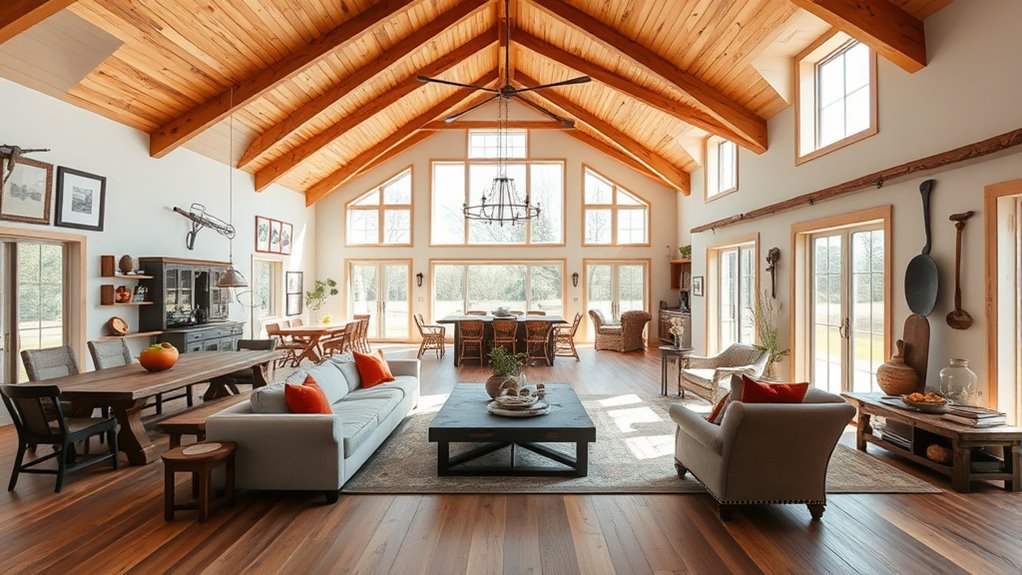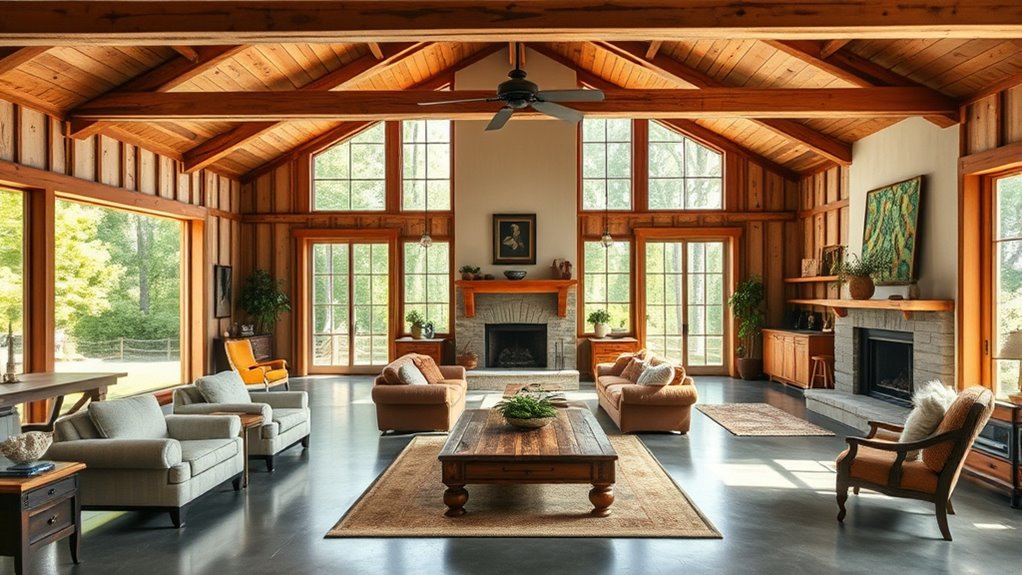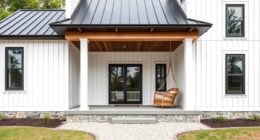Open-plan farmhouse living makes your space feel larger, brighter, and more inviting by embracing natural light and rustic charm. It offers great flexibility, allowing you to host gatherings or adapt areas for work or relaxation. However, it can pose challenges with noise, privacy, and clutter control. With thoughtful planning, you can balance openness with coziness and organization. Want to explore how to maximize these benefits while managing the tradeoffs? Continue to discover practical tips and ideas.
Key Takeaways
- Open-plan layouts maximize natural light, creating bright, inviting spaces that enhance rustic textures and farmhouse charm.
- They offer flexibility for hosting, working, or relaxing, with adaptable zones and multi-functional furniture.
- The absence of walls promotes a sense of connection but can lead to noise issues and privacy concerns.
- Maintaining a cohesive aesthetic requires careful planning to prevent clutter and ensure rustic decor complements open sightlines.
- Overall, open-plan farmhouses foster warmth and versatility but need thoughtful organization to balance openness and privacy.

Open-plan farmhouse living combines rustic charm with modern functionality, creating a space where you can easily move between the kitchen, dining, and living areas. This design emphasizes openness, making your home feel larger and more inviting. One of the key advantages is natural lighting. Because there are fewer walls blocking the sunlight, large windows and open sightlines allow natural light to flood the entire space. This not only brightens your home but also reduces the need for artificial lighting during the day, saving energy and creating a warm, welcoming atmosphere. Natural lighting also highlights the earthy textures and rustic finishes that define farmhouse style, making your space feel cozy yet vibrant. To enhance the authentic farmhouse feel, incorporating vintage decor can further emphasize the charm and character of the space.
Open-plan farmhouse living maximizes natural light, warmth, and rustic charm for a spacious, inviting home environment.
Another benefit of open-plan farmhouse living is space flexibility. Without the constraints of walls dividing rooms, you gain the ability to adapt your space as needed. You can host gatherings with ease, as everyone can mingle comfortably across the open layout. When you need a quiet retreat, you can define smaller zones using furniture placement or rugs, creating a sense of separation without physical barriers. This flexibility allows your home to evolve with your changing needs—whether you’re working from home, entertaining guests, or relaxing with family. You can also incorporate multi-functional furniture, like extendable tables or storage benches, to maximize the usability of your open space.
However, this openness comes with its tradeoffs. You’ll need to think about how to manage noise, as sounds travel easily across the open plan. If you prefer quiet or privacy, this could be a downside. Additionally, maintaining a cohesive look can be challenging, since different zones need to harmonize visually to avoid cluttered or disjointed aesthetics. Storage can also be tricky; without walls, you might need creative solutions to keep clutter out of sight and maintain a tidy appearance.
Despite these tradeoffs, open-plan farmhouse living offers a distinctive blend of charm and practicality. The abundance of natural lighting enhances the rustic details, while space flexibility allows you to craft a home that adapts to your lifestyle. With thoughtful planning—such as strategic placement of furniture and sound-absorbing elements—you can enjoy the benefits of this design while minimizing its drawbacks. Ultimately, this style encourages a sense of connection and ease that’s perfect for those who value a warm, versatile, and inviting home environment.
Frequently Asked Questions
How Do I Maintain Privacy in an Open-Plan Farmhouse?
To maintain privacy in your open-plan farmhouse, you can strategically arrange furniture to create cozy zones that feel separate. Incorporate decorative screens or folding partitions to add visual barriers without sacrificing style. Use rugs, curtains, or tall plants to define areas and add a sense of enclosure. These simple adjustments help you enjoy an open space while maintaining personal privacy and comfort when needed.
What Are the Best Ways to Reduce Noise in Open Spaces?
While the openness invites energy and connection, it also amplifies noise. To reduce sound, you can use soundproofing techniques like sealing gaps around doors and windows. Incorporate acoustic paneling on walls to absorb sound and minimize echo. Rugs and soft furnishings also help dampen noise, creating a calmer environment. These steps let you enjoy the spacious feel without sacrificing peace and quiet in your open farmhouse.
How Does Open-Plan Living Affect Energy Efficiency?
Open-plan living can boost energy efficiency if you address insulation challenges and optimize HVAC efficiency. Without proper insulation, heat escapes easily, increasing your energy bills. A well-designed HVAC system can better circulate air throughout the open space, reducing energy waste. You should consider adding strategic insulation and upgrading your HVAC to guarantee consistent temperature control, making your open-plan farmhouse more energy-efficient and comfortable year-round.
Can Open-Plan Farmhouses Accommodate Large Families Comfortably?
Yes, open-plan farmhouses can comfortably accommodate large families with thoughtful multi-generational design. You can create designated zones for privacy and shared spaces for togetherness. Incorporate smart storage solutions to keep the area organized and clutter-free. By planning with your family’s needs in mind, you’ll guarantee everyone has enough room to relax and connect, making your farmhouse a welcoming, functional home for all generations.
What Are Effective Ways to Personalize Open-Concept Farmhouse Interiors?
Imagine walking into your open-concept farmhouse and feeling instantly at home. To personalize the space, you use decorative accents that reflect your style—rustic signs, vintage finds, or colorful textiles. Thoughtfully arranging furniture creates cozy zones, making the large space inviting and functional. Layering these elements adds warmth and personality, turning the open area into a true reflection of you while maintaining the farmhouse charm.
Conclusion
While open-plan farmhouse living offers spaciousness and connection, it also invites noise and a lack of privacy. The endless flow of shared space fosters warmth and togetherness, yet can feel overwhelming when you’re craving solitude. Embracing this lifestyle means balancing the charm of open intimacy with the challenge of constant visibility. Ultimately, it’s a choice between the freedom of openness and the comfort of privacy—each side revealing a different facet of farmhouse life.









